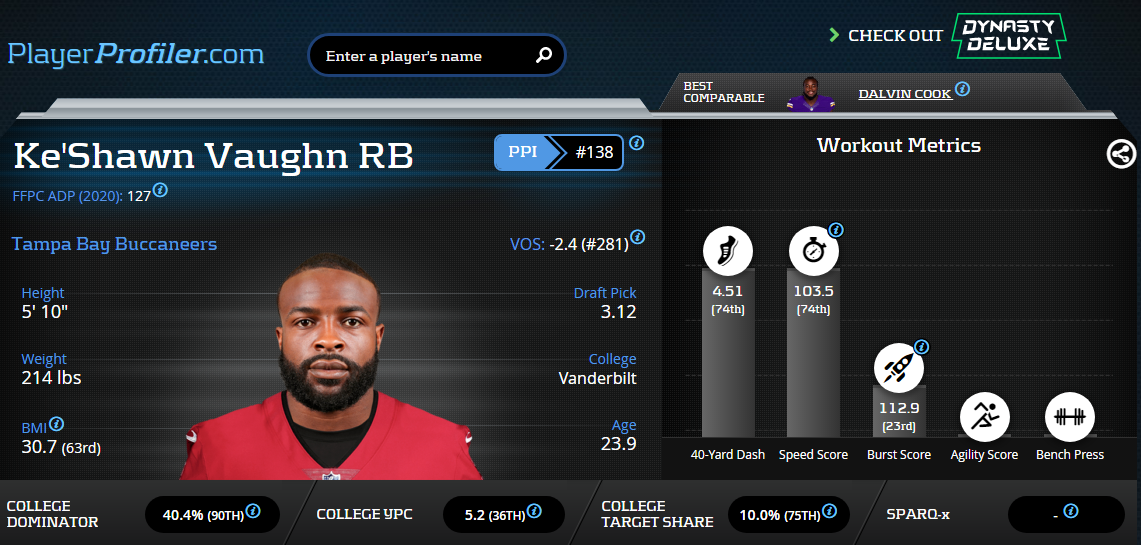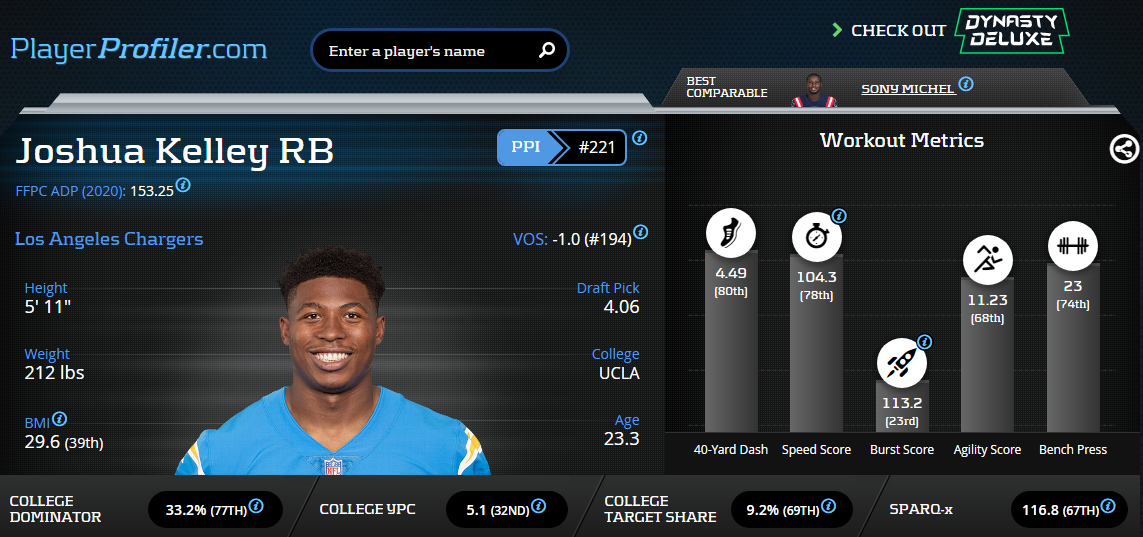Now that the Super Bowl is in the rearview mirror, the fantasy football community heads into the long offseason. That doesn’t mean there isn’t work to be done, however. In fact, the offseason can be a busy time for those playing in dynasty leagues. March will bring about free agency in the NFL, April the draft. Every transaction provides new information to apply to the fantasy football world.
In the offseason, roster maintenance and draft preparation become the main objectives. Benches need to be weeded through to make room for the coming rookies, leading to decisions both easy and difficult. Trading is an aspect of roster maintenance that can do wonders for a dynasty squad. The following tactics are sure to improve a roster ahead of rookie draft season.
Better a Year Early…
When it comes to the running back position in dynasty formats, the best a manager can do is stay young. The adage, “better a year early than a year late” rings true. As described in the Start-Up Draft Strategies article, backs over the age of 26 rarely finish in the top 10 in fantasy. The last time it occurred was in 2017, with both LeSean McCoy (age 27) and Mark Ingram (age 29) finishing No. 6 and No. 7, respectively. This information should not be ignored.
This information reveals that running backs on their first contracts are the most productive, and the ones to roster in dynasty. These players have already accumulated massive workloads by the time the second contract approaches. This isn’t the same for wide receivers or tight ends, who can maintain high-end production until age 30, beyond for some. The same goes for quarterbacks; Tom Brady will likely still be playing football on Mars years after the rest of us have perished on Earth.
The above reasons are why trading away running backs nearing age 26-27, or are approaching/on that second contract, is the most optimal move. For this offseason, Dalvin Cook is a prime candidate. He’ll be 26 when the season starts and though he is the focal point of the Viking offense, he’s had a difficult time staying healthy. Since arriving as a rookie in 2017, he’s yet to play a full 16 game season. The production decline isn’t far away, but Cook is coming off of a season in which he ranked No. 2 among qualified running backs in Fantasy Points per Game. It’s the perfect time to sell. And if he crushes it in 2021? Better a year early.
The “Buy-Low” Philosophy
The idea is simple; target players that leaguemates value less. The execution can be more difficult given the variance on player “values.” Whether it’s due to a down year, a lack of a breakout or injury, players tend to lose value in some fantasy minds. Sure, the fading is fair for a good number of them, but not all. The hunt may prove elusive, though it is well worth the reward.
A Bear of a Value
In 2020, David Montgomery paid dividends to those who took a chance on him. The second-year back finished No. 4 in total PPR fantasy points after finishing No. 24 in his rookie campaign. He ranked No. 6 or higher in several RB opportunity metrics this past season, including Snap Share (No. 4), Carries (No. 4), Targets (No. 6) and Red Zone Touches (No. 6). The same goes for his production categories; No. 5 in Rush Yards, No. 4 in Receiving Yards and No. 6 in Fantasy Points per Game.
While many expected improvement from Montgomery, a top-5 fantasy finish was thought of (accurately) as far-fetched at best. Those who traded for him on the cheap garnered a ton of value. Not only was he valuable in 2020, but now he can be sold to the highest bidder. Though the production was there, his efficiency was not. Aside from logging 449 (No. 4) Yards Created and a 27.1-percent (No. 10) Dominator Rating, he ranked outside the top-10 in all other PlayerProfiler efficiency metrics. Holding him isn’t a bad choice, but trading him could be the better one.
Running back Damien Harris and receiver Robby Anderson are two other examples of players that increased their value. Harris was practically free last year after garnering four touches as a rookie. Heading into 2021, he’s a strong bet to start at the position for New England. There were questions about Anderson’s new surroundings after signing with the Panthers; he was entering a crowded receiver room with Teddy Bridgewater at quarterback. He ended up finished No. 19 in total points, ahead of both D.J. Moore and Curtis Samuel.
Targets for 2021
There are several names that come to mind for the coming season, some more obvious than others. Ezekiel Elliott will be targeted, as will Odell Beckham; both veterans aiming for a bounceback year. Others will look to youth in the form of players such as Denzel Mims and D.J. Chark, hoping the improvement comes. Not all buy-low targets are as obvious, however. There are less talked about players worth trading for, and will come at a cheaper price.
Ke’Shawn Vaughn and Bryan Edwards are players that had moderate expectations going into their rookie seasons. The year didn’t go as planned for either, but 2021 presents an opportunity for both to redeem themselves. Edwards will walk into a less crowded receiver room with opportunity abound. His lack of workout metrics does raise some questions, but his stellar College Dominator Rating and Breakout Age suggest there’s no reason to bail on him yet.
Signs point to Vaughn being back as the No. 2 in the Tampa Bay run game behind Ronald Jones. Like Edwards, the rookie season was disappointing, but he gained a year of meaningful experience as the Bucs went on their Super Bowl run. With Leonard Fournette likely not returning, Vaughn will be the guy in Tampa’s high-powered offense should Jones regress or suffer an injury. Trade for this man before it’s too late.
Chris Herndon is another solid name to target after a down year in 2020. A player many expected to break out, he struggled to become a factor while missing a few games to injury. However, he got hot down the stretch, catching 14 of 17 passes for 145 yards and two touchdowns over the last three games. Coaching may not be everything, but history has shown what happens when Adam Gase leaves a player’s life. It’s Wheels Up for Herndon in 2021.
Rookie Draft Picks
The key with rookie draft picks is to avoid both overvaluing first rounders and undervaluing third rounders. First round picks have, roughly, a 50-percent chance of hitting. Going back to 2015, around half of all first round picks end up being relevant enough to return the value of the pick (using ADP data from FantasyFootballCalculator). The first rounds of rookie drafts are littered with misses; Samaje Perine, John Ross, Josh Doctson, Derrius Guice and many more. Of course, that doesn’t mean it’s time to sell all first rounders.
Picks early in the first are extremely valuable; they provide a better chance at nabbing an elite prospect. The player pool dwindles along with talent as the draft continues. In addition, the picks lose value. The later a first round pick, the more optimal it becomes to use in a trade for a reliable player. How about the 1.10 and Henry Ruggs for Calvin Ridley? Hell yes. Conversely, third round rookie picks are more valuable then they seem.
Looking at ADPs of rookie drafts for the last handful of years reveals a plethora of talented, fantasy relevant players drafted in the third round. These include Chris Godwin, Kenny Golladay and Josh Allen, as well as Antonio Gibson and Chase Claypool in 2020. The round was also home to one of the top wideouts in the game; Stefon Diggs. Even in his first season on a new team, normally challenging for receivers, he finished No. 3 in PPR scoring last season. In this round are gems abound! Not to mention, third rounders are great as throw-ins.
Throw-Ins
A sneaky little way to add talented players, or third round picks, that are off of others’ radars are by adding them to a trade as “throw-ins.” Over the years, numerous players have broke out after seasons of irrelevancy. Logan Thomas is a great example of a player that wasted away on the end of rosters, or waiver wires, for years. In 2020, at the age of 29, the former quarterback finished fourth at tight end with 176.6 fantasy points.
When making a trade, these are the perfect players to target as “throw-ins.” Trade doesn’t feel quite even, throw in Raheem Mostert and we have a deal. Sure, everyone loves Darren Waller now, but it wasn’t until his age 27 season that he became a name to know. Hell, some might not even remember he was drafted by Baltimore. Yet, after years of no production he suddenly bloomed and put himself in the upper echelon of tight ends. Imagine how many Waller truthers got him as a throw-in.
Do We Have a Deal?
For 2021, there are a few key names to shoot for; Joshua Kelley, Andy Isabella and Ian Thomas. Kelley had a disappointing rookie season for the Chargers. Sure, he began the year behind starter Austin Ekeler and backup Justin Jackson, but he did little to take advantage of the time Ekeler missed with injury. Kalen Ballage was later signed and had some decent moments, though he is currently a free agent. When the ‘21 season begins, Kelley will be in the same spot as the previous year; third on the depth chart. Should opportunity come calling again, perhaps he can do more with it this time around.
Isabella is another young player that had high expectations at one point in time but has been relegated to the background. That may change this coming season. Larry Fitzgerald appears to be on the verge of retirement. If he goes that route, Isabella would be in prime position to take some of those Vacated Targets as the third receiver. Add in another year for the Cardinals offense to grow, and he could bring back a sneaky return in investment.
When it comes to the tight end position, there are several players to keep an eye on; Kahale Warring, Foster Moreau, Josh Oliver and others. However, Carolina’s Thomas should be at the top of everyone’s list. Yes, we were high on him last offseason and his 2020 was rather quiet. However, he’ll be 25 when the new year starts and in his second season with coach Matt Rhule and his system. With a quarterback upgrade likely coming, as well as vacated targets should Curtis Samuel leave, Thomas is setup for success.
Conclusion
The goal of every offseason in fantasy football is to improve rosters through any means necessary. The NFL Draft and the waiver wire are helpful in their own ways, but mastering the art of the trade can be beneficial to your squad for years to come. Reject stagnancy; send out those offers throughout the offseason using these tactics and build a squad to be reckoned with. There’s a method to the madness, as they say, and the madness will produce the results desired.






